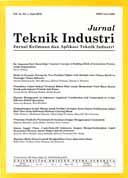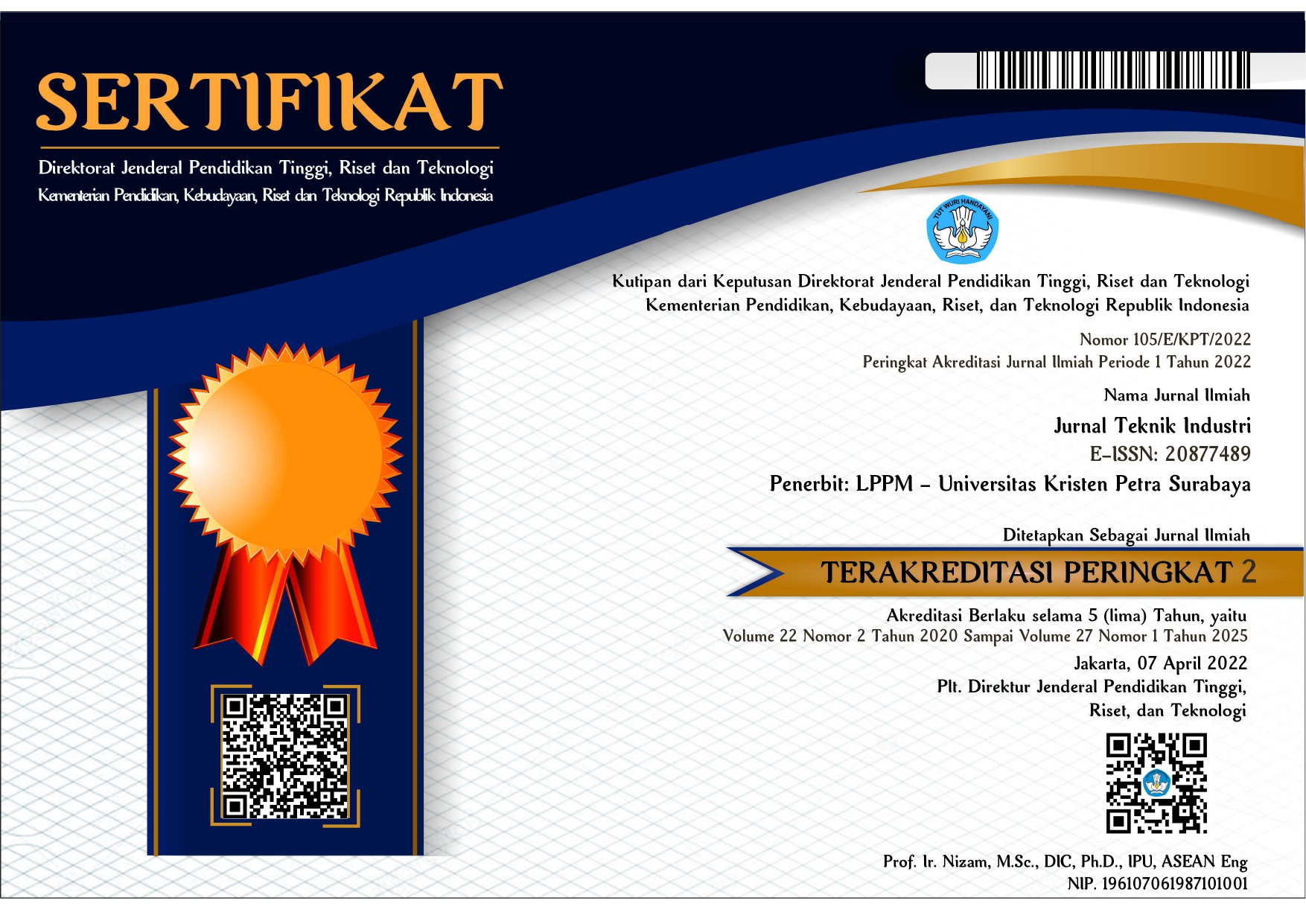Modeling the Multi-channel Section in the Supply Chain System using the Multiserver Queue Analogy
DOI:
https://doi.org/10.9744/jti.23.1.47-54Keywords:
supply chain, multi channel, reproduction point, production stopping time, markovian modelAbstract
The industry generally consists of a supply chain system. The main constituents of any supply chain system are suppliers, manufacturers, distribution centers, and retailers. The system configuration can be straight chain, branched, cyclic, or a combination of all. An analytical model is needed to study system behavior as a result of the dynamics of its constituents. Modeling a multi-channel section becomes quite a challenging job in this regard. A method of modeling the multi-channel section will be discussed in this paper by adopting multi-server queues. As is well known, in a multi-server queue, there is a branching point at which the flow of entities begins to spread across several parallel servers. In the modeling perspective of this paper, the branching point is in the buffer (finished good warehouse in the factory, i.e., the focal echelon). That is the end of the waiting line from which the entity specifically moves to one of the servers, or in this context; it is called a channel. In this paper, the number of channels can be any, generalizable, can be more than two. Hence, the subsystem studied includes a factory, finished product warehouse, and several distribution centers. The factory produces by the mechanism of, where and r are stopping point and production restarting point, respectively. Production stops when the quantity of finished product in the warehouse reaches units and will restart the production when the quantity drops to the same or lower than units. The model is developed under Markovian assumptions by considering the quantities of production rates, the number of distribution centers (channels), travel time from factories to each distribution center, delivery lot size, and the time between the arrival of orders from distribution centers. The system under study is seen as a case of two echelons, namely factories and distribution channels. The numerical model obtained is applied to one case example with certain conditions. Comparisons with discrete simulation results give relatively small and acceptable differences. So, in the future, this model can complement the overall modeling of the supply chain system, a multi-echelon system with multi-channel distribution.
Downloads
References
Murdapa, P.S., Pujawan, I N., Karningsih, P.D., and Nasution, A. H., A Numerical Analysis Model Involving Carbon Emissions in a Single Echelon Supply Chain Systems with Two Distribution Channels: A Preliminary Model Proposed, The 6th International Conference of Industrial Engineering and Applications (ICIEA), IEEE, 2019, Waseda, Japan
Karaman, A. and Altiok, T.R., Approximate Analysis and Optimization of Batch Ordering Policies in Capacitated Supply Chains, European Journal of Operational Research, 193, 2009, pp. 222–237.
Saetta, S., Paolini, L., Tiacci, L. and Altiok, T., A Decomposition Approach for the Performance Analysis of a Serial Multi-echelon Supply Chain, International Journal of Production Research, 50(9), 2012, pp. 2380–2395.
Murdapa, P.S., Pujawan, I N., Karningsih, P.D., and Nasution, A. H., Incorporating Carbon Emissions in Queuing Models to Determine Lot Sizes and Inventory Buffers in a Supply Chain. International Journal of Intelligent Enterprise, 7(4), 2020, pp. 373-390
Xiong, W. and Altiok, T., An Approximation for Multi-server Queues with Deterministic Reneging Times, Annals of Operations Research, 172, 2009, pp. 143–151.
Koroliuk, V. S., Melikov, A. Z., Ponomarenko, L. A., and Rustamov, A. M.,Methods for Analysis of Multi-channel Queueing System with Instan-taneous and Delayed Feedbacks, Cybernetics and Systems Analysis, 52(1), 2016, pp.58-70
Pryshchepa, O. V. and Lebedev, E. O., On a Multi–channel Retrial Queueing System, Cybernetics and Systems Analysis, 53(3), 2017, pp.441-449
Sultan, A. M., Hassan, N. A. and Elhamy, N. M., Computational Analysis of a Multi-server Bulk Arrival with Two Modes Server Breakdown, Mathematical and Computational Applications, 10(2), 2005, pp. 249-259
Sultan, A. M., Multi-channel Bi-level Heteroge-neous Servers Bulk Arrival Queueing System with Erlangian Service Time, Mathematical and Computational Applications, 12(2), 2007, pp. 97-105
Ke, J.C., Wu, C.H., and Pearn, W.L., Analysis of an Infinite Multi-server Queue with an Optional Service, Computers & Industrial Engineering 65, 2013, pp. 216–225
Goswami, V., Analysis of Discrete-time Multi-server Queue with Balking, International Journal of Management Science and Engineering Management, 9(1), 2014, pp. 21–32.
Liberopoulos, G. and Dallery, Y., Base Stock versus WIP Cap in Single-stage Make-to-stock Production Inventory Systems, IIE Transactions, 34, 2002, pp. 627–636
Gershwin, S.B. and Schor, J.E., Efficient Algorithms for Buffer Space Allocation, Annals of Operations Research 93, 2000, pp. 117–144
Tan, B., and Gershwin, S. B., Analysis of a General Markovian Two-stage Continuous-flow Production System with a Finite Buffer, Interna-tional Journal of Production Economics, 120, 2009, pp. 327–339
Tan, B., and Gershwin, S. B., Modelling and Analysis of Markovian Continuous Flow Systems with a Finite Buffer, Annals of Operations Research, 182(1), 2011, pp. 5–30
Le Bihan, H. and Dallery, Y. A Robust Decomposition Method for the Analysis of Production Lines with Unreliable Machines and Finite Buffers, Annals of Operations Research 93, 2000, pp. 265–297
Matta, A., Dallery, Y., and Di Mascolo, M., Analysis of Assembly Systems Controlled with kanbans, European Journal of Operational Research, 166, 2005, pp. 310–336
Karaesmen, F. and Dallery, I., A Performance Comparison of Pull Type Control Mechanisms for Multi-stage Manufacturing, International Journal of Production Economics, 68, 2000, pp. 59-71
Helber, S., Approximate Analysis of Unreliable Transfer Lines with Splits in the Flow of Material, Annals of Operations Research, 93(1-4), 2000, pp. 217-243
Salsabila, N.Y., Siswanto, N., Widodo, E., and Rochmadhan, O. K., Throughput Analysis on a Multi-stage Manufacturing System, Jurnal Teknik Industri, 21(2), December 2019, pp. 69-78.
Downloads
Published
How to Cite
Issue
Section
License
Articles published in the Jurnal Teknik Industri: Jurnal Keilmuan dan Aplikasi Teknik Industri will be Open-Access articles distributed under the terms and conditions of the Creative Commons Attribution License (CC BY).
![]()
This work is licensed under a Creative Commons Attribution License (CC BY).



















